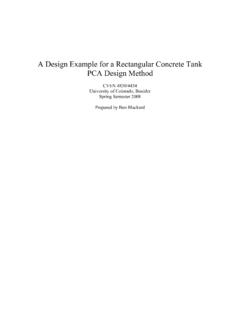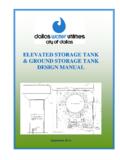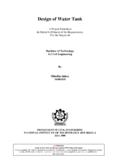Transcription of ROOFTOP WATER TANKS - North River Railway
1 ROOFTOP WATER TANKSA clinic presented by BOB VAN CLEEF of the North River RailwayFIRST WATER TANKSR oman Cistern from about 200 BC WATER TANKS have existed since the dawn of man. The first crude TANKS were pits or underground caverns where rain WATER accumulated. These were eventually shaped and lined with stone. Romans developed a system of aqueducts to fill some of these PLUMBING The Romans were not the first to build extensive WATER distribution systems by they were the first to do so in grand style. Huge aqueducts conveyed WATER from WATER sources in higher elevations into towns. Lead pipes conducted both potable WATER and sewage within towns. WATER always traveled by gravity through these channels that sloped slightly WINDMILLS Windmills are another ancient invention. They were thought to be first used in Persia, circa 1400BC for grinding corn and other grains. Later versions like those in Holland were used to pump WATER . Windmills were the electric motor used to provide power wherever needed up until the industrial MODERN PLUMBING The Industrial Revolution (18thand 19thCenturies) brought many changes modern inventions like this convenience included copper-lined wooden TANKS .
2 WATER flowed horizontally and were filled by buckets from the ON THE FARM Farms had their own problems with increased demands for WATER . It was not feasible to pipe city WATER to rural farms. Windmills were put to work drawing WATER for stock and domestic use. Huge versions of the WATER closet were installed in barns or on ground-level TANKS to store WATER for when the winds died BARELS FOR TRAINSS tephan's Rocket with wooden barrel used to hold WATER Somewhere around the 1840s a few enterprising barrel makers saw a new opportunity. They watched thirsty steam locomotives leave the wet confines of the mines and wander across the dry land. This they realized was a new need for their skillsEARLY RAILROAD WATER TANK As the number of locomotives grew it became impractical to pump WATER from the ground on a as-needed basis. Trackside barrels were built, then rapidly grew in size with more and larger engines. Soon, the well known iconic WATER TANKS for thirsty steam engines sprang up everywhere the tracks wandered, almost always accompanied by a OF THE WINDMILL Electricity and electric motors soon caused the windmills to disappear.
3 Winds were not always sufficient to maintain WATER supply. Motors were more dependable and easier to maintain; TANKS could be built smaller. Thousands of gallons could still gush from a 6 pipe to fill a tender in IN THE CITIESW ater could now flow horizontally, vertically and all around to wherever it was needed. Indoor plumbing began to take on new demands Gravity was no longer able to keep up with domestic needs It was discovered that a WATER tank at least 30 feet high could be used to maintain a highly desirable constant pressure . ROOFTOP TANKS WATER TANKS sprouted on every roof in town thru the 20thcentury, especially where there was no central city WATER system. These TANKS proved more than simply a better supply of WATER . They proved extremely useful in case of fires. TANKS so dominated the skyline in every city for the next 100 years. Larger cities such as New York by the 19th century, required that all buildings higher than six stories be equipped with a ROOFTOP WATER tower for fire safety.
4 Two companies continue to build wooden towers even today. Wood has been proven a better insulator than steel and keeps the WATER from freezing in winter. While WATER TANKS beside railroad tracks have become obsolete, there are hundreds of thousands in other uses Today. These towers have taken on many shapes over the years and many are now made of steel A few have taken on many complex shapes such as this interesting House in the clouds. QUESTION: How many antelopes can fit in a WATER tank?ANSWER: There is no definitive answer as WATER TANKS were built in so many shapes and sizes. In fact, almost no two TANKS were the same the way, a typical RR tank held about 100,000 to 200,000 gallons of HIGH IS THE TANK?WHERE IS THE TANK?WHAT COLOR?WHAT KIND OF ANTELOPES?HOW OLD ARE THEY?SO LET US BEGIN Start by making (2) disks. These will determine the size of the tank Make TANKS nearest the front of the table larger than those to the back to add THE CORE Use a convenient size block to use as a spacer.
5 Round one corner of the block to follow the curve of the disks. Glue this spacer block between the two disks. This will determine the tower SCRIBED SIDING Use a thin piece of scribed siding to form the sides. Moisten one side to cause the wood to curl. Glue around disks. The ends do not have to meet exactly but should meet over the rounded corner of core spacer block Wrap with thread to hold in place while glue TO INSTALL BANDS Insert common pins into the spacer block at the rounded corner between the ends of the siding. These will anchor the bands around the Tank. Bands varied from 1-2 feet at the bottom to 2-4 feet at the top depending on the THE BANDS Black thread will be used to simulate the bands around the tank. Wax the thread to reduce the fuzz and to make it easier to position around the tank. Nylon fishing line or black magnet wile can also be used. Optional details include adding turnbuckles and band endsINSTALL BANDS Tie one end of the thread to the lower-most pin.
6 Lace the thread around the pins making one wrap of the tank on each pin Tie and glue the thread on the last pin. Black or brown magnet wire can be used for smaller TANKS in the HEIGHT GAUGE Early TANKS had a simple system for measuring the WATER depth. A rope was tied to a float inside the tank, looped over a pulley, and tied to a small pointer on the side of the tank. This ran through some sort of channel painted white for visibility. This can be simulated by a piece of stripwood ROOF The roof will be made from a normal sheet of stripwood. I prefer to add shingles to the roof before cutting the pieces. These can be either cedar or tar paper. Some towers didn t even have a roof at ROOF INTO SEGMENTS Most towers and eight sides with a pitch of about fifteen degrees. Make a template for one roof segment. Trace and cut the segments to POST FOR ROOF Cut a small disk and glue to the top disk of the tower. This will help position the roof segments as they are glued in place.
7 Drill a small hole in the center of this disk for the THE FINALE The finale can be purchased commercially. They can also be made from telescopic brass tubing. Solder one of two sizes and turn down using a drill or lath. Glue to the top of the tankROOF ASSEMBLY Assemble the roof. Bevel the bottom edges of each segment To fit tightly together Bevel the top edge slightly. Wires can will be added to resemble flashingORA small section of T beam can be THE BASE Start with a circle representing the outside diameter of the tank. The dotted lines are 3 -6 beyond the diameter. The carrier beams generally form a square platform. Round platforms were common on large TANKS . The legs of the bents form a square near the diameter of the SIMPLE JIG TO FORM THE BENTS The top always positions the top beam of the bent The left side always positions one leg of the bent. A shim is used on the right side to position the right leg. This arrangement makes it easy to make different sizes of bents.
8 Add sway braces. And trim to sizeJOIN BENTS Sway bracing is used to join the bents together in a DECK Add the carrier beams to the top of the bents to form the deck. Sand top smooth. Glue tank to deck Stain and weather as DETAILS Use your imagination here. Add a ladder from the roof to the top of the tank Add turnbuckles and/or fittings to hold the ends of each band. There should be a ground wire from the finale extending down the outside of the building to the ground . Now build a few dozen more TANKS in different sizes and add to each building or cluster of buildings on layout. More supplies and also a section dealing with the history of plumbingThis presentation has been brought to you by the North River RailwayBob Van Cleef46 BroadwayCoventry, CT 06238 END









